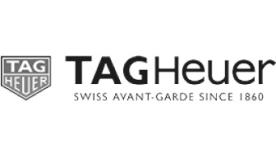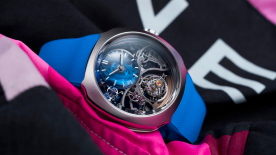How would you sum up 2016 for Hublot, TAG Heuer and Zenith ?
Overall, I’d say it’s been an excellent year since we will have jointly progressed 5 to 6% compared with last year, whereas the watch industry has a whole has more or less slid by 10%. That is remarkable and it means we have gained 15% in terms of market share. I’ve always distinguished growth from progress with regard to competitors. Given that we’re in a difficult economic situation at the moment, one has to target market shares. If one were to see this exercise in terms of a cycling race, it’s during an Alpine climb that you need to put your foot down in order to break away from the pack. Naturally you don’t move as fast as on flat terrain, but what counts is remaining ahead of the competition. Secondly, I also note that TAG Heuer will have had what is probably the best year of its history. Since 1860, TAG Heuer has racked up a number of achievements, but what a feat to be able to vaunt the best ever results within current circumstances ! For Hublot the year has been just as good as the previous one, and this for a brand enjoying uninterrupted growth since 2004, which is amazing! Meanwhile, Zenith has followed the overall industry trend for an obvious reason: the brand is suffering from the same weaknesses as watchmaking in general relating to its excessive dependence on China. Zenith was selling half of its watches to the Chinese, including a number of gold timepieces, which are now seen in a poor light due to corruption. They have thus lost ground in terms of both quantity and value.
What highlights can we expect in 2017 ?
As far as TAG Heuer is concerned, the highlights will be linked to the Chinese space program and the brand’s return to cycling, from which it had been absent since the late 1970s. Our partnership with the BMC team will notably take the form of a substantive presence on the Tour de France. Alongside the usual events with which Hublot is associated, the year will be punctuated by commemorations of Ferrari’s 70th anniversary. Close and intense cooperation will be expressed through a hundred or so events held around the world. For Zenith, the year will bring the real launch of its partnership with Range Rover, as well as the association with Kevin Spacey who will become the brand ambassador.
What does your partnership with the
Chinese space program involve ?
China and its army have launched an ambitious space program with which TAG Heuer is associated. The clocks in the control room are supplied by TAG Heuer, which will also handle countdowns. The Chinese space agency program directors will take part in jointly organized events and we will be part of certain celebrations. We also have all the models of lunar and Mars rover vehicles so as to create in-store visibility, and we will of course create a dedicated watch developed in conjunction with the China National Space Agency.
Which other challenges await TAG Heuer in the coming years ?
A mechanical watch revolution on the one hand; and ongoing smartwatch technology transfer on the other. From 2017
onwards, around 50 people
will begin assembling micro-
processors in-house. This
will be Switzerland’s first
ever microprocessor assembly
line, located in a white room in
TAG Heuer premises in La Chaux-
de-Fonds, where ten or so engineers
will be responsible for R&D projects
on connected objects. On the mechanical watch front, TAG Heuer is planning
to overturn 400 years of watchmaking history by delivering a fundamental innovation, notably stemming from the field of metallurgy. This essential technological breakthrough will be a new milestone that will go down in the history books.
Does the fact of belonging to a group still
offeradvantages?
Even though we are keen to maintain the independence of each brand, heading up all three enables me to leverage synergies on several levels. Let’s not forget that Hublot is a full-fledged Manufacture that not only produces 20,000 movements and buys just as many, but also produces its cases and composes its alloys. Zenith is of course a historical Manufacture, and TAG Heuer will produce 120,000 mechanical movements next year, along with 300,000 cases and 500,000 dials. With three production facilities of this quality, this scope and this degree of competency, the synergies are truly colossal! We can also mutualize R&D, such as areas relating to Hublot’s exceptional metallurgy lab. As far as distribution is concerned, we are also seeing that two strong brands can help the weakest one to keep pace.
Watchmaking is facing stiff competition from other fields in terms of the manner of consuming luxury ; how can it maintain its appeal ?
The answer is simple: watchmaking must prepare for a powerful and marked consumer change that will doubtless prove fatal to brands which have failed to grasp its nature. The new consumers in the making are around 20 years old today, and neither their lifestyle nor their habits resemble those we now know. Children no longer follow the path traced by their parents and they affirm their differences far more clearly than in the past. For example, many of them no longer bother to take their driving license ; they have another vision of luxury. Everything that was strong and stable in the past has become unstable. There are sweeping changes and upheavals that we need to observe and understand, while projecting ourselves into this reality. To take the example of an 18-year-old prepared to spend 500 euros for a pair of Adidas or Nike sneakers: what will he buy when he’s 38? The brands unable to make the prospective leap will miss the boat. We are already seeing this in China, where TAG and Hublot were offering products that did not correspond to the perception of luxury among Chinese clients in the 2010s, which was instead based on elegant classic watches. Chronographs were not viewed as a luxury product and our marketing investments were not enough to change clients’ mentality. It took the impetus driven by the Chinese state which instructed major entrepreneurs to invest in sport, and notably in soccer, for changes to occur. Jack Ma, the boss of Alibaba, therefore acquired a 51% stake in the Guangzhou Evergrande football club which won the Chinese league, while the Beijing club was taken over by another billionaire. Jack Ma has built a village of 3,000 apartments with 30 soccer pitches to create the world’s biggest football training school. Player transfers in China have become the most expensive of any football leagues worldwide! Sport has entered a new dimension and the up-and-coming generation is now investing in objects linked to sport, including watches. Young people are now interested in Hublot and TAG Heuer and no longer in the super-slim watches worn by their parents. Adapting to such shifts will be decisive.









